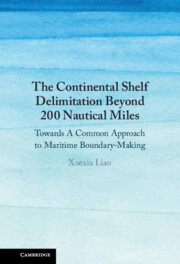 The Continental Shelf Delimitation Beyond 200 Nautical Miles
The Continental Shelf Delimitation Beyond 200 Nautical Miles Book contents
- The Continental Shelf Delimitation Beyond 200 Nautical Miles
- The Continental Shelf Delimitation Beyond 200 Nautical Miles
- Copyright page
- Contents
- Figures
- Table of Cases
- Table of Treaties
- Foreword
- Preface
- Abbreviations
- 1 Legal Uncertainties in the Continental Shelf Delimitation beyond 200 NM
- Part I Overlapping Entitlements to the Continental Shelf beyond 200 Nautical Miles
- 2 Establishing the Entitlement to the Continental Shelf beyond 200 NM
- 3 Defining Overlapping Entitlements to the Continental Shelf beyond 200 NM
- 4 Interaction between Delineation and Delimitation of the Continental Shelf beyond 200 NM
- Part II Delimitation Methodology for the Continental Shelf beyond 200 Nautical Miles
- Book part
- Bibliography
- Index
3 - Defining Overlapping Entitlements to the Continental Shelf beyond 200 NM
from Part I - Overlapping Entitlements to the Continental Shelf beyond 200 Nautical Miles
Published online by Cambridge University Press: 08 October 2021
- The Continental Shelf Delimitation Beyond 200 Nautical Miles
- The Continental Shelf Delimitation Beyond 200 Nautical Miles
- Copyright page
- Contents
- Figures
- Table of Cases
- Table of Treaties
- Foreword
- Preface
- Abbreviations
- 1 Legal Uncertainties in the Continental Shelf Delimitation beyond 200 NM
- Part I Overlapping Entitlements to the Continental Shelf beyond 200 Nautical Miles
- 2 Establishing the Entitlement to the Continental Shelf beyond 200 NM
- 3 Defining Overlapping Entitlements to the Continental Shelf beyond 200 NM
- 4 Interaction between Delineation and Delimitation of the Continental Shelf beyond 200 NM
- Part II Delimitation Methodology for the Continental Shelf beyond 200 Nautical Miles
- Book part
- Bibliography
- Index
Summary
Maritime delimitation presupposes an area of overlapping entitlements. Instead of focusing solely on the geomorphological and geological elements of the entitlement, this chapter surveys the State practice in order to contextualize the determination of overlapping entitlements to the continental shelf beyond 200 nm. Factors including the outer limits of the continental shelf, maritime delimitation within 200 nm, and the existence of multiple claims to the same continental shelf beyond 200 nm may play out in the determination of the overlapping entitlements to the continental shelf beyond 200 nm. Moreover, two scenarios wherein the existence of overlapping entitlements is doubtful are also examined. The first concerns the situation where two different parties invoke the two continental shelf criteria under Article 76 of the United Nations Convention on the Law of the Sea in a confined maritime area, which underlies the disputes of the Nicaragua v. Colombia cases. The other concerns the "zone-locked" scenario, in which a State’s access to the continental shelf beyond 200 nm is closed off by a maritime boundary within 200 nm.
Keywords
Information
- Type
- Chapter
- Information
- The Continental Shelf Delimitation Beyond 200 Nautical MilesTowards A Common Approach to Maritime Boundary-Making, pp. 51 - 99Publisher: Cambridge University PressPrint publication year: 2021